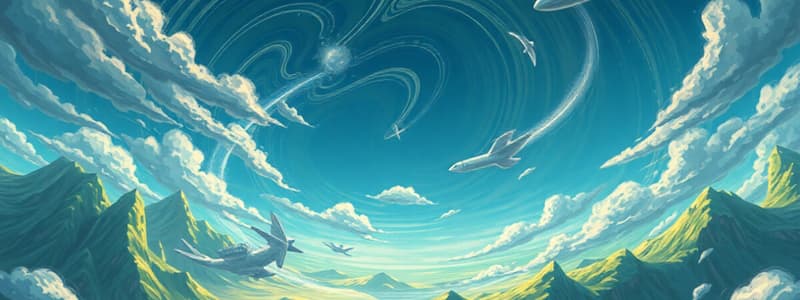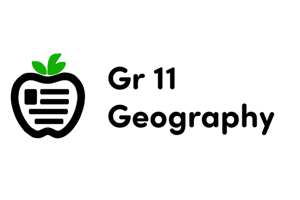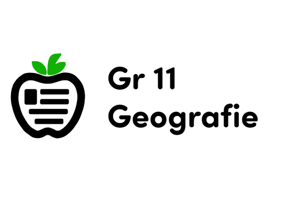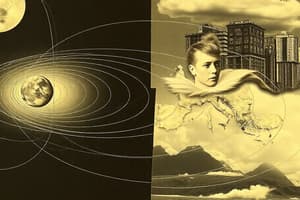Podcast
Questions and Answers
Which of the following best describes the primary cause of the Equatorial Low-Pressure Belt?
Which of the following best describes the primary cause of the Equatorial Low-Pressure Belt?
- Intense solar heating and rising air (correct)
- Convergence of polar and subtropical air masses
- Deflection of trade winds by the Coriolis Effect
- Sinking of cold, dense air
The Subtropical High-Pressure Belts, located around 30° N and S, are primarily characterized by rising air, leading to frequent cloud cover and rainfall.
The Subtropical High-Pressure Belts, located around 30° N and S, are primarily characterized by rising air, leading to frequent cloud cover and rainfall.
False (B)
What is the primary force that deflects global winds, creating patterns such as the Trade Winds and Westerlies?
What is the primary force that deflects global winds, creating patterns such as the Trade Winds and Westerlies?
Coriolis Effect
Winds that blow from the subtropical high-pressure zones to the subpolar low-pressure zones are known as ______.
Winds that blow from the subtropical high-pressure zones to the subpolar low-pressure zones are known as ______.
Match the pressure belt with its corresponding latitude range:
Match the pressure belt with its corresponding latitude range:
Which of the following is a characteristic of the Polar High-Pressure Belt?
Which of the following is a characteristic of the Polar High-Pressure Belt?
Trade winds blow from the Equator towards the subtropical high-pressure belts.
Trade winds blow from the Equator towards the subtropical high-pressure belts.
What is the name given to the zone of calm winds associated with the Equatorial Low-Pressure Belt?
What is the name given to the zone of calm winds associated with the Equatorial Low-Pressure Belt?
The subtropical high-pressure belts are also known as ______.
The subtropical high-pressure belts are also known as ______.
Which global wind system plays a significant role in influencing mid-latitude weather and driving ocean currents?
Which global wind system plays a significant role in influencing mid-latitude weather and driving ocean currents?
Flashcards
Equatorial Low-Pressure Belt
Equatorial Low-Pressure Belt
Area around 0° latitude with rising air, calm winds, clouds, and heavy rain.
Subtropical High-Pressure Belt
Subtropical High-Pressure Belt
Area around 30° N/S with descending air, dry conditions and is associated with deserts.
Subpolar Low-Pressure Belt
Subpolar Low-Pressure Belt
Area around 60° N/S where warm and cold air masses converge, creating storms.
Polar High-Pressure Belt
Polar High-Pressure Belt
Signup and view all the flashcards
Low Pressure Formation
Low Pressure Formation
Signup and view all the flashcards
High Pressure Formation
High Pressure Formation
Signup and view all the flashcards
Trade Winds (Easterlies)
Trade Winds (Easterlies)
Signup and view all the flashcards
Westerlies
Westerlies
Signup and view all the flashcards
Polar Easterlies
Polar Easterlies
Signup and view all the flashcards
Coriolis Effect
Coriolis Effect
Signup and view all the flashcards
Study Notes
- Earth's atmospheric pressure changes because solar heating is uneven.
- Pressure differences drive global pressure belts.
- Pressure belts affect global wind patterns.
Major Pressure Belts
- There exist four major pressure belts on Earth.
Equatorial Low-Pressure Belt (Doldrums)
- Positioned at 0° latitude (Equator).
- High temperatures induce rising air.
- This belt is characterized by calm winds.
- Expect frequent cloud cover.
- Expect heavy rainfall.
Subtropical High-Pressure Belt (Horse Latitudes)
- Located around 30° N and 30° S latitudes.
- Sinking air from the Equator causes dry conditions.
- Stable atmospheric conditions.
- Associated with major deserts.
- Examples include the Sahara and Kalahari.
Subpolar Low-Pressure Belt
- Found around 60° N and 60° S latitudes.
- Warm air meets cold polar air, causing cyclones.
- Frequent storms.
- Unstable weather conditions.
Polar High-Pressure Belt
- Located at 90° N and 90° S (poles).
- Cold, dense air sinks.
- Conditions tend to be dry, cold, and stable.
Formation of High and Low Pressure
Low Pressure
- Forms where air heats up.
- Air expands and rises.
- Examples include the Equator and Subpolar regions.
High Pressure
- Forms where air cools.
- Air contracts and sinks.
- Examples include the Subtropics and Polar regions.
Global Winds and Their Patterns
- Global winds are due to pressure differences.
- The Earth’s rotation (Coriolis Effect) also dictates Global winds.
- There exist three major wind systems.
Trade Winds (Easterlies)
- Blow from subtropical high-pressure belts (30° N/S) toward the Equator.
- Deflected westward by the Coriolis Effect.
- NE trade winds occur in the Northern Hemisphere.
- SE trade winds occur in the Southern Hemisphere.
- They play a key role in tropical weather patterns.
Westerlies
- Blow from subtropical high-pressure zones (30° N/S) to subpolar low-pressure zones (60° N/S).
- Deflected eastward by the Coriolis Effect.
- They influence mid-latitude weather.
- Drive ocean currents.
Polar Easterlies
- Blow from polar high-pressure belts (90° N/S) to subpolar low-pressure belts (60° N/S).
- Cold, dry winds are deflected westward by the Coriolis Effect.
- They cause extreme cold conditions in polar regions.
- Global wind systems drive weather patterns.
- Global wind systems drive ocean currents.
- Global wind systems drive climatic conditions worldwide.
- Crucial for distributing heat.
- Crucial for distributing moisture.
Studying That Suits You
Use AI to generate personalized quizzes and flashcards to suit your learning preferences.
Description
Explore Earth's pressure belts: the Equatorial Low (Doldrums), Subtropical High (Horse Latitudes), Subpolar Low, and Polar High. Uneven solar heating causes pressure differences, influencing global wind patterns and climate. Discover how these belts drive weather phenomena.




